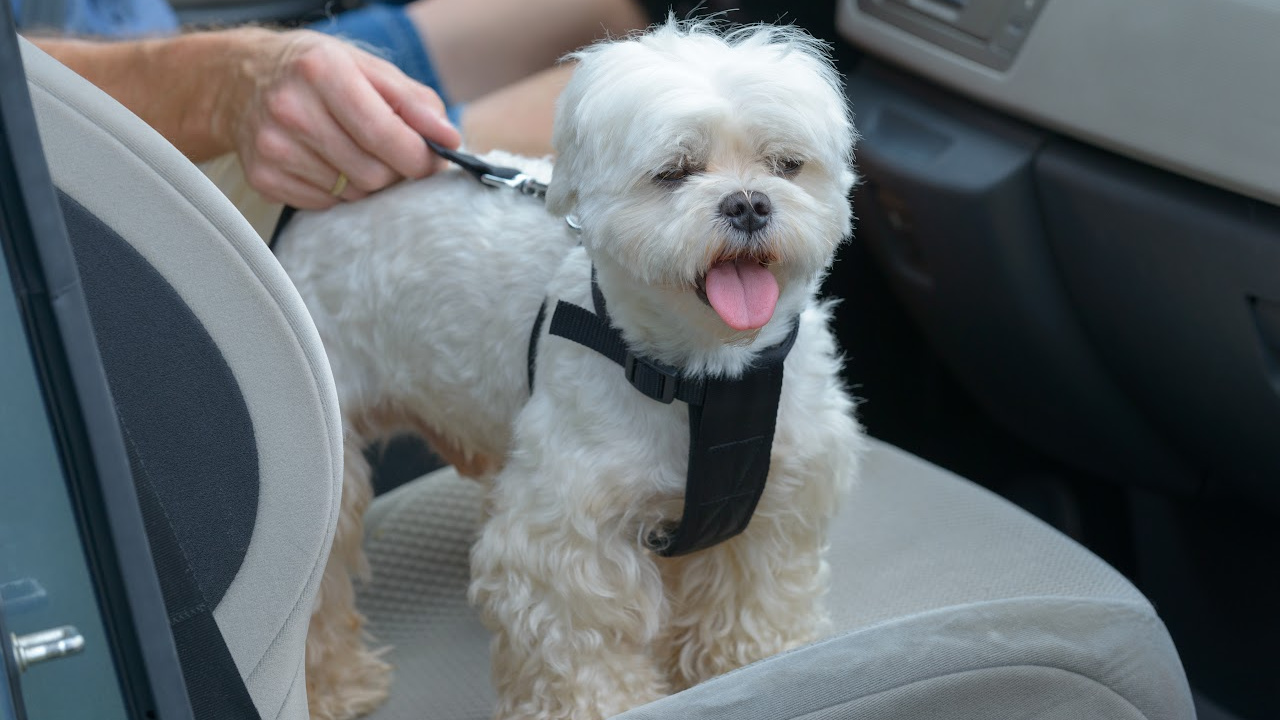Welcome to our guide on feeding your Mini Dachshund. This post aims to provide you…

Law on Dogs in Cars UK: How to Avoid a Fine and Keep Your Pet Safe
Driving with your dog in the UK? It’s not just about keeping your pet comfy, it’s also about following the law. Rule 57 of the UK Highway Code is something every dog-owning driver needs to know about. Not following it could lead to fines and even affect your car insurance.
This blog post will give you a clear overview of the legal guidelines for restraining dogs in vehicles and the serious consequences of not doing so.
Key Takeaways
- Secure Your Dog: UK law requires dogs to be safely restrained in cars to prevent distractions and injuries.
- Avoid Fines: Not securing your dog can lead to fines up to £5,000 and affect your car insurance.
- Choose the Right Restraint: Pick a suitable restraint method like a seat belt harness, pet carrier, or dog cage for your dog’s safety and comfort.
What are the UK Laws on Dogs in Cars?
In the UK, taking care of our dogs on car journeys isn’t just about being a responsible pet owner, it’s also the law. Rule 57 of the UK Highway Code states that dogs must be ‘suitably restrained’ in a vehicle when travelling. This important rule is designed to keep your dog safe and to prevent them from distracting you or causing injury to passengers.
So, what does ‘suitably restrained’ mean? According to the Highway Code, it could be:
- A seat belt harness
- A pet carrier
- A dog cage
- A dog guard
Each of these methods has its own benefits and is suitable for different breeds, sizes, and temperaments.
Rule 57 of the Highway Code Explained
Rule 57 of the Highway Code is all about ensuring the safety of everyone in the vehicle, including your pets. It’s not just about stopping your dog from jumping on your lap while you’re driving. It’s also about protecting your pet from injuries during sudden stops.
Following Rule 57 is essential for preventing accidents on the road. But what happens if you don’t follow this rule? Let’s find out.
The Consequences of Not Following the Law
Ignoring the UK laws on transporting dogs in vehicles can have serious consequences. If you don’t comply with Rule 57, you could face a fine of up to £5,000 and may even have to appear in court. Plus, driving with unrestrained pets can lead to charges such as driving without due care and attention or dangerous driving.
And it doesn’t stop there. If you don’t properly restrain your dog in your vehicle, it could invalidate your car insurance. This adds a significant financial risk on top of any fines. So, how do you choose the right restraint for your dog?
How to Choose the Right Restraint for Your Dog
Choosing the right restraint for your dog is about safety, comfort, and following UK laws. From seat belt harnesses and pet carriers to dog cages and guards, each method has its own advantages and is suitable for different dog breeds, sizes, and temperaments.
Let’s take a closer look at each of these restraint methods.
Seat Belt Harnesses
A seat belt harness can be a great choice if you’re planning to secure your dog in the back seat. These harnesses can:
- Prevent your dog from being ejected in a crash
- Reduce the risk of injury if an airbag deploys
- Distribute the impact force with padded straps, protecting your dog’s body in a collision.
However, it’s important to tether the harness properly. This allows your dog to sit and lie down comfortably, while also preventing them from sticking their heads out the window. Remember, not all dog seat belts are crash-tested, so their effectiveness in an accident could vary.
Pet Carriers and Dog Cages
For smaller breeds or puppies, pet carriers and dog cages can be a good alternative to seat belt harnesses. They provide restraint while maintaining comfort and safety. But remember, each dog is unique, so it’s important to choose the right restraint method for your pet.
Final Thoughts
Travelling with your dog in the UK can be a joyous experience, but it’s important to remember the legal responsibilities that come with it. By understanding and following Rule 57 of the UK Highway Code, you can ensure a safe and enjoyable journey for both you and your pet. Remember, a little preparation can go a long way in avoiding fines and keeping your pet safe.
FAQ
What does the UK law say about dogs in cars?
The UK law, specifically Rule 57 of the UK Highway Code, states that dogs must be ‘suitably restrained’ in a vehicle when travelling.
What does ‘suitably restrained’ mean?
‘Suitably restrained’ could mean using a seat belt harness, a pet carrier, a dog cage, or a dog guard.
What are the consequences of not following Rule 57 of the Highway Code?
Non-compliance with Rule 57 can lead to a fine of up to £5,000, a court appearance, and potentially invalidate your car insurance.
Can a passenger hold a dog in a car?
No, a passenger holding a dog does not constitute a ‘suitably restrained’ pet as required by the Highway Code.
How can I choose the right restraint for my dog?
The right restraint for your dog depends on their breed, size, and temperament. Options include seat belt harnesses, pet carriers, dog cages, and guards.
Are seat belt harnesses safe for dogs?
Yes, seat belt harnesses can prevent your dog from being ejected in a crash, reduce the risk of injury if an airbag deploys, and distribute the impact force with padded straps.
Can I use a pet carrier or dog cage for my dog in the car?
Yes, for smaller breeds or puppies, pet carriers and dog cages can be a good alternative to seat belt harnesses.
What should I do if my dog gets motion sickness in the car?
If your dog suffers from motion sickness, it’s best to consult with your vet as they may be able to prescribe medication.
Can my dog hang out the window of the car?
No, while it may look cute, it’s highly dangerous. Dogs can suffer horrific injuries after hitting a passing vehicle while hanging out of a car.
Can airbags harm my dog in a car accident?
Yes, if your dog is secured in a harness in the front seat, be sure to move the seat as far back as possible and switch off the passenger-side airbag as it may do more harm than good if you have an accident.
FAQ
What are the new rules for dogs in cars UK?
Make sure to restrain your dog in the car to prevent them from disturbing the driver. You can use a dog crate, pet carrier, dog harness, or a dog guard for the car’s boot.
Are dogs allowed in front seat of car UK?
Yes, dogs can travel in the front seat of a car in the UK as long as you use a seatbelt harness and take safety precautions like switching off the passenger airbag and moving the seat back as much as possible.
Is it illegal for dogs to be unrestrained in a car?
Yes, it is illegal for dogs to be unrestrained in a car. You must have them suitably restrained to avoid disturbing the driver.
What are the consequences of non-compliance with Rule 57?
If you don’t comply with Rule 57, you could face a fine of up to £5,000, potential court appearances, charges of careless driving, and it might even invalidate your car insurance. Be sure to follow the rules to avoid these consequences.
What are the different types of dog restraints for car travel?
When travelling with your dog, use a seat belt harness, pet carrier, dog cage, or dog guard to keep them safe in the car. Make sure to choose the option that best suits your dog’s size and preferences.


